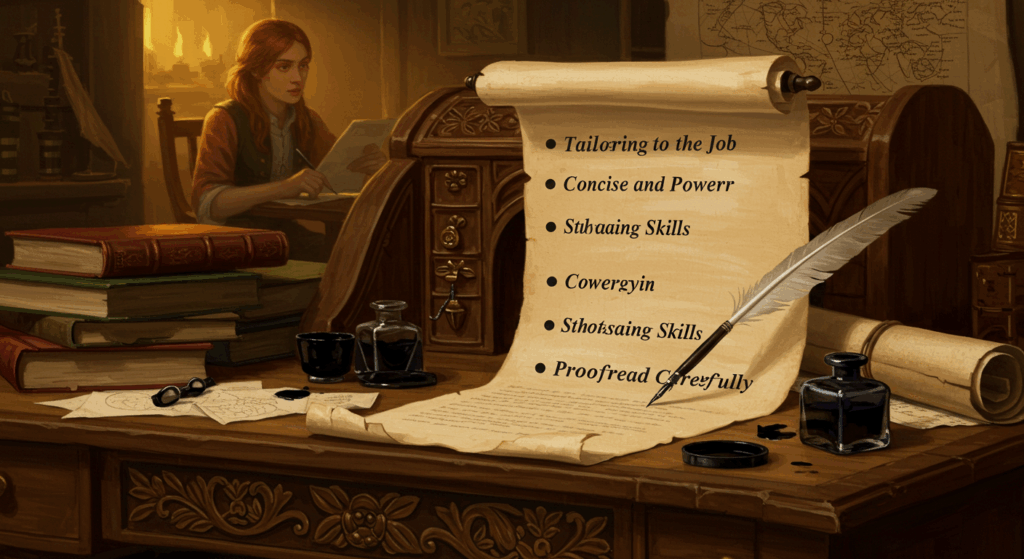If writing a cover letter makes you want to open Netflix, dim the lights, and pretend jobs don’t exist… same, honestly. But also: a great cover letter is low-key a cheat code. It’s your highlight reel, your “hey, I’m not just a résumé PDF” moment. When it lands, you get interviews. When it flops, well—hello, resume pile.
Good news: you don’t need a PhD in Shakespeare to write a great one. You just need a few step-by-step instructions, some simple best practices, and a short list of common mistakes to dodge. I’ll show you all of that, plus ready-to-steal mini templates you can copy, paste, and tweak. We’ll keep it casual, a little messy (on purpose), and very real. Let’s do this.
Why a Cover Letter Still Matters (Even in 20XX)
Think of your cover letter as a voiceover for your résumé. Your résumé says what you did; the cover letter explains why it maters for this role. It’s also where you show you understand the company and can solve their specific problems. Ngl, that last bit is the whole game.
A strong cover letter can:
- Connect your career dots (especially if you’re changing fields or have a gap).
- Prove you read the job description (and didn’t just mass-apply at 2am).
- Make you memorable (stories > bullet points).
- Get you past “meh” and into “let’s interview this one.”
Step-by-Step Instructions: From Blank Page to “Let’s Talk”
You asked for step-by-step instructions, so I’m giving you the exact moves. Follow these in order, and you’ll end up with a clean, targeted letter that sounds like you.
1) Read the job posting like a detective
Skim once, then read again slowly. Highlight:
- Top 3–5 responsibilities (their priorities).
- Repeated keywords (tools, skills, certifications).
- Phrases hinting at pain points: “fast-paced,” “cross-functional,” “scaling,” “improve retention,” “reduce churn.”
Goal: decide the two or three wins from your history that best match their needs. That’s your story spine.
2) Quick research (the 10-minute stalk)
Hop to their site, LinkedIn, maybe recent news. Grab two insights:
- What they’re building or fixing right now.
- How your work would plug into that.
You don’t need a thesis. Just enough to say, “I see you, and here’s how I help.”
3) Set up the header (clean and boring—on purpose)
At the top:
- Your name, phone, email, portfolio/LinkedIn.
- Date.
- Hiring manager’s name + company + location (or “Remote”).
Format tip: Keep it simple. Same font as your résumé. One page max (ideally 250–400 words).
4) Greet like a person
If you have a name: “Hi [Name],” or “Hello [Name],”
No name? “Hello [Team/Department/Hiring Committee],” works. Avoid “To Whom It May Concern” unless you want to sound like a haunted fax machine.
5) Hook them with one punchy opening
Your first 1–2 sentences should:
- Mirror their role: “I’m a [X] who’s delivered [Y]…”
- Land a relevant metric: “cut onboarding time by 35%,” “grew MRR 22%,” “handled 60 tickets/day with 95% CSAT.”
Example:
“I’m a lifecycle marketer who grew trial-to-paid conversions by 22% at a SaaS startup—and I’d love to bring that enmergy to [Company] as your Growth Marketing Manager.”
6) Middle paragraph: match their needs with your receipts
Use 2–4 short lines or bullets. Each line should include:
- Action you took,
- Context (tool/team/stage), and
- Result (ideally with numbers).
Example bullets:
- Led cross-functional launch of referral program (PM, Eng, Design), adding ~18% of new signups in 3 months.
- Rebuilt onboarding emails in Customer.io; A/B tested 8 variants → +31% activation.
- Partnered with Sales to define MQL criteria; reduced lead waste 27% and cut CAC by ~12%.
Make it scannable. Recruiters love scannable.
7) Show you “get” the company
One tiny paragraph (like, two sentences) connecting your work to their mission, product, or moment.
Example:
“What excites me about [Company] is your push into creator tools. I’ve shipped features for a similar audience at [Previous Co], so I’m comfortable optimizing for time-to-value and reducing drop-off in week one.”
This is where your research pays off. You’re not just good—you’re good for them.
8) Close with confidence + a next step
Be polite, forward, and easy to reply to.
Example:
“Would love to share a 5-minute Loom walking through my campaign results, if helpful. Either way, I’d be excited to learn more about your roadmap and where I can help.”
Add a friendly sign-off:
“Thanks so much,” / “Appreciate your time,”
Your Name
Optional but spicy: a P.S. with a bonus proof, link, or reference. People weirdly always read the P.S.
9) Name the file like a pro
Firstname-Lastname-Company-Role-Cover-Letter.pdf
Not Coverletter-final-FINAL-v7-USETHIS.pdf (we’ve all been there).
10) Proofread (sorry, but yes)
Read it out loud. Use a tool (spellcheck, grammar). Then ask a friend. Then read once more. Two extra minutes here can prevent “I love Company X” sent to Company Y—aka the most tragic of common mistakes.
Mini Templates You Can Steal (and Tweak)
Use these as starting points. Personalize the metrics, swap the tools, and adjust the vibe to match your field.
General Professional (Most Roles)
Hello [Hiring Manager Name],
I’m a [Your Role] with [X years] of experience helping [audience] do [result]. At [Most Relevant Company], I [action], which led to [metric/result]. I’m excited about the [Job Title] role at [Company] because [1–2 lines about their product/mission/moment].
A few highlights:
- [Action] → [Result/metric] using [tool/technique].
- [Action] → [Result/metric]; collaborated with [teams].
- [Action] → [Result/metric]; improved [KPI] by [X%].
What draws me to [Company] is [specific thing you researched]. I’d love to bring my experience in [skills] to help [goal they care about], especially around [feature/initiative].
Thanks for your time—happy to share a quick Loom or case study.
Best,
[Your Name]
[Portfolio/LinkedIn]
P.S. Here’s a quick sample of [relevant work]: [link].
Entry-Level / No Experience (But You’ve Got Projects)
Hello [Hiring Team],
I’m graduating from [School/Program] this spring and I’m applying for your [Role]. In the last year, I built [project] that [result], led [club/initiative], and completed [course/cert]. I’m excited by [Company] because [specific mission/product detail].
Relevant wins:
- Built [project] using [tech], achieving [metric/impact].
- Led [group] of [#] to [outcome]; presented to [audience].
- Completed [course/cert]; shipped [thing] in [tool].
I’m drawn to the [Role] because it combines [skill] and [skill], which I practiced in [class/project]. I’d love to contribute that energy to your team.
Thanks for considering my application!
Cheers,
[Your Name]
[Portfolio/GitHub/LinkedIn]
Career Switcher (Own the Narrative)
Hello [Name],
After [# years] in [previous field], I’m transitioning into [new field]—and the [Role] at [Company] is the perfect match. My background in [transferable skill] means I’m already comfortable with [relevant task]. Recently, I completed [bootcamp/course] and shipped [project] that [result].
What I bring:
- [Transferable skill] from [old field] applied to [new task] → [result].
- [Project] with [tool]; solved [problem] and improved [metric].
- [Soft skills]: stakeholder comms, prioritization, owning outcomes.
I admire [Company’s] [mission/product], especially your push into [X]. I’d love to bring my [unique angle] to help [goal].
Appreciate your time,
[Your Name]
Referral/Pipeline Fast-Track (If Someone Internally Recommended You)
Hello [Name],
[Referrer Name] suggested I reach out about the [Role]. I’ve been following [Company] since [hook], and my experience in [skill area] maps closely to your needs.
Highlights:
- [Action] → [Result] (tool/process).
- [Action] → [Result]; worked with [teams].
- [Action] → [Result]; improved [KPI] by [X%].
I’d love to share more context on the results that [Referrer Name] mentioned and how I can help accelerate [Company]’s [goal].
Thanks so much,
[Your Name]
Best Practices That Actually Work
This is the part where we shift from generic advice to best practices you can implenment in, like, 15 minutes:
Keep it focused (one page, three sections)
Aim for: hook → proof → fit + CTA. No novels. No memoirs. If it wouldn’t make a recruiter say “oh nice,” cut it.
Mirror their language (lightly)
If they say “customers,” don’t say “clients.” If they say “OKRs,” don’t say “KPIs,” unless both are relevant. This is one of those best practices that sounds tiny but helps with skimming and ATS.
Numbers > adjectives
“Strong communicator” is fine. “Led weekly cross-team syncs for 18 people; cut blockers by 40%” is better. Numbers are little truth bombs.
Show, don’t tell
Instead of “I’m passionate about fintech,” try “I built a small tool that pulls transaction summaries and reduces manual reconciliation by 60 minutes/week.” Passion = proof.
Add a human note
One sentence that shows personality (not chaos). “I grew up helping in my family’s shop, so ops efficiency is kind of my love language.” Cute. Relatable. Memorable.
Include a soft CTA
“Happy to send a quick Loom walking through my results,” or “Would love to discuss how we might reduce your activation drop-off.” It’s confident, not thirsty.
Save a custom version per company
It’s extra clicks, yes. But when you apply to 5–10 roles, you’ll reuse 80% and tweak 20%. That 20% is the difference-maker. Another best practices gem: version control in a simple Google Drive folder.
Common Mistakes (And How to Dodge Them)
Let’s be blunt. These common mistakes sink good candidates:
Sending the same letter everywhere
If you don’t say anything specific about the company, they assume it’s not specific to them. Fix: include two company-tailored lines (mission/product/current push).
Rewriting your résumé in paragraph form
No one wants a paragraph-shaped resume. Fix: pick 2–3 stories that make sense for this role. Add numbers. Keep it tight.
Starting with “My name is…”
They can see your name. Open with a relevant win instead. You’ve got, like, 3 seconds to make an impression.
Name or company typos (the heartbreakers)
It happens. But please triple-check. If you’re applying to Spotify, don’t write “Spotfiy” (lol, ngl I’ve done this; it burns).
Being vague about impact
“Worked on marketing emails” is meh. “Rewrote onboarding emails → +31% activation” is clear. Avoid the common mistakes of leaving results implied.
Oversharing personal stuff
A dash of personality? Cute. Your entire life story? Maybe save for the coffee chat.
File chaos
We already said it: clean filenames. PDF unless they ask for DOCX. Make sure links are public.
Sounding like ChatGPT wrote it (ironic, hi)
If your letter reads like a corporate press release, add one sentence that sounds like you. A little “you know,” “I’m excited about…,” or a tiny joke can fix the vibe without killing professionalism.
Make It ATS-Friendly Without Killing the Vibe
Yes, ATS exists. No, you don’t need to write like a robot. Here’s the balanced take:
- Use keywords from the job description—especially core skills and tools (e.g., “Figma,” “SQL,” “HubSpot,” “B2B,” “OKRs,” “Agile”).
- Place them naturally in your proof points, not in a weird keyword dump.
- Keep formatting simple: standard fonts, no text boxes, no funky columns.
- Export as PDF unless the posting says otherwise.
Pro move: skim the role again and check you’ve mirrored 5–7 keywords. That tiny pass can boost your match score.
A Fast, Repeatable Writing Formula
When you’re in a rush (we all are), use this skeleton:
- Hook: “I’m a [role] who [relevant, quantified win]… excited about [Company] because [specific reason].”
- Proof bullets (2–4): Action → tool → result (+ metric).
- Fit: One sentence linking your background to their current goals or product.
- CTA: “Happy to send a short Loom/case study,” + polite sign-off.
This is your “best practices in 6 lines” cheat. It’s also easy to customize per company.
Tone: How Casual Is Too Casual?
A good rule: write like you’d talk to a respected coworker you actually like. A little voice, not chaos. A tiny “hmm” or “lol” is fine for startups; more formal companies might prefer clean and crisp. If you’re unsure, read the job posting’s tone. If it says “We’re scrappy and weird,” you can be 10% weirder. But if it’s very buttoned-up (finance, legal), keep jokes to a breath.
“Best Practices” Checklist (Copy-Paste This)
- One page (250–400 words)
- Personalized first line with a metric
- 2–4 proof bullets w/ numbers
- One line showing company understanding
- Gentle CTA + thanks
- Clean filename, PDF
- Two passes of proofreading
- Keywords mirrored naturally
- Optional P.S. for bonus link
Stick this at the top of your drafting doc. It saves brain cells.
Quick “Step-by-Step Instructions” Recap (TL;DR)
Because I love you and also I know attention spans (mine included):
- Read job post → pick 2–3 matching wins.
- Research 10 mins → find one relevant company detail.
- Set clean header → greet a human, if possible.
- Hook with a quantified result.
- Add 2–4 proof bullets (action → tool → result).
- Show you “get” them (fit line).
- Close w/ friendly CTA + P.S. option.
- Save as PDF with a pro filename.
- Proofread (out loud, then tools).
- Send it and don’t overthink (ok, overthink a tiny bit).
These step-by-step instructions are the core of your system. Repeat them for every application and iterate like a product roadmap.
Real Examples of Proof Bullets (Mix & Match)
Sometimes the hardest part is turning your experience into crisp bullets. Steal the structure, swap the nouns:
- Customer Success: “Handled ~60 tickets/day with 95% CSAT; built macros that cut response time by 28%.”
- Sales: “Exceed quarterly quota by 18% avg; piloted new discovery script that improved win rate from 24% → 31%.”
- Design: “Redesigned onboarding flow in Figma; reduced time-to-first-value by ~36% after usability tests (n=18).”
- Data/Analytics: “Built automated revenue dashboard in BigQuery/Looker; cut monthly reporting from 6 hours → 15 minutes.”
- Ops: “Centralized vendor process; negotiated contracts to save ~$45k/year; created SOPs for 9 workflows.”
- Content/SEO: “Published 24 articles/quarter; grew organic traffic 64% YoY; improved CTR from 2.1% → 3.5% with title tests.”
Notice the pattern? Action → tool → measurable outcome. It’s the best practices trifecta.
If You Have Gaps, Short Stints, or Non-Linear Paths
It’s ok. Many of us do (pandemic, layoffs, life). Address it briefly and move on:
- Gap: “I took 8 months to handle family responsibilities and complete a certification in [X]. Since then, I’ve shipped [project/result].”
- Short stint: “I joined [Company] for a time-boxed contract to [goal]; wrapped ahead of schedule and delivered [result].”
- Non-linear: “My background in [field] gives me [transferable skill] that’s directly useful in [new field], as I proved in [project/result].”
Own the narrative. Then pivot to value.
Formatting that Helps (and Doesn’t Annoy)
- Font: Inter, Calibri, Cambria, Georgia, or Helvetica. 10.5–12 pt.
- Margins: ~1 inch. Lots of white space.
- Length: 3–5 short paragraphs or 1 short intro + 2–4 bullets + 1 short close.
- Links: Make sure they’re live and public.
- Attachments: Name them like a sane person.
- Accessibility: High contrast, no walls of text, no 10-point gray on gray (pls).
Small moves, big readability.
Extra “Common Mistakes” to Keep on a Sticky Note
- Apologizing for lacking a requirement (“I know I don’t have X…”)—frame what you do bring and your plan to ramp.
- Overusing buzzwords without evidence (synergy!!). Add a result or cut it.
- Getting too long or too clever with formatting—cute for Dribbble, not for ATS.
- Forgetting the CTA. Invite the next step.
- Sounding desperate. You’re talented, not begging.
These are the common mistakes that accidentally turn strong candidates into “pass.” Avoid them and you’ll stand out—promise.
Example: A Tight, Targeted Letter (Put It All Together)
Hello Maya,
I’m a customer-obsessed Support Lead who scaled a team from 3 → 11 while maintaining 95%+ CSAT, and I’d love to bring that to Northbeam as your Customer Support Manager. At Sparrow, I overhauled our help center and workflows, cutting first-response times by 42% and reducing escalations by ~30% in six months.
Highlights:
- Built Zendesk triggers/macros for the top 12 intents; average handle time dropped from 8:12 to 5:46.
- Launched a QA rubric + weekly scorecards; agent coaching bumped resolution quality from 86% → 93%.
- Partnered with Product on a feedback loop (Jira tags + themes); shipped two fixes that reduced login-related tickets by 18%.
I’m excited about Northbeam’s growth in ecommerce analytics and your focus on trustworthy attribution (I’ve supported analytics tools before, so data accuracy + education are kinda my jam). I’d love to chat about how we can keep response times low as volume scales this holiday season.
Thanks for your time—happy to share a short Loom walking through the macros and scorecards we used.
Best,
Alex Riley
alexr.dev • linkedin.com/in/alexr
P.S. Here’s a 2-minute walkthrough of our Zendesk setup: [link].
Notice: hook, proof, fit, CTA. Metrics, tools, outcomes. Clean. Human. Reusable.
How to Edit in 8 Minutes (Step-by-Step Instructions for Polishing)
- Minute 1–2: Read out loud. Circle any line that feels vague.
- Minute 3: Replace adjectives with numbers or examples.
- Minute 4: Trim filler (“I believe,” “I think,” “I’m writing to apply for”).
- Minute 5: Add one company-specific sentence.
- Minute 6: Mirror 5–7 keywords naturally.
- Minute 7: Check names, links, and filename.
- Minute 8: Save as PDF and send before you second-guess everything.
These step-by-step instructions make editing so much faster—and yeah, it’s one of those best practices you’ll actually keep using.
Quick FAQ (Because You’re Probably Wondering)
How long should a cover letter be?
The sweet spot is 250–400 words. If you’re over 500, you’re probably telling stories better suited for the interview.
Do I always need one?
If the posting says optional, it’s secretly not. A strong letter differentiates you fast.
Should I repeat my résumé points?
Don’t copy/paste. Use the letter to provide context and impact for the most relevant wins.
PDF or DOCX?
PDF unless they explicitly ask for DOCX or a text field.
What if I have no exact experience?
Lead with transferable skills + projects + results. Then show you understand their business.
Final Pass: Your Cover Letter Game Plan
Here’s the move, friend: open a doc and write three things—
- one hook with a metric,
- three proof bullets with action → tool → result,
- one fit line showing you did the homework.
Then add a simple CTA, a quick thanks, and a P.S. if you’ve got a cool link. That’s it. You’ve followed solid step-by-step instructions, you’ve applied best practices, and you dodged the common mistakes most people make. You’re miles ahead.
You’ve got this. Seriously. Go write that letter, hit send, and line up that interview.









